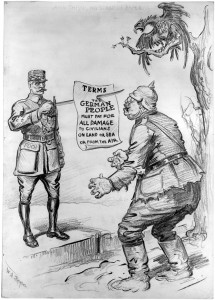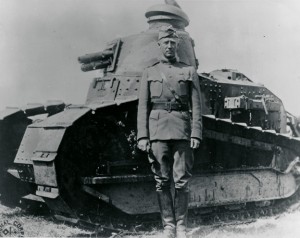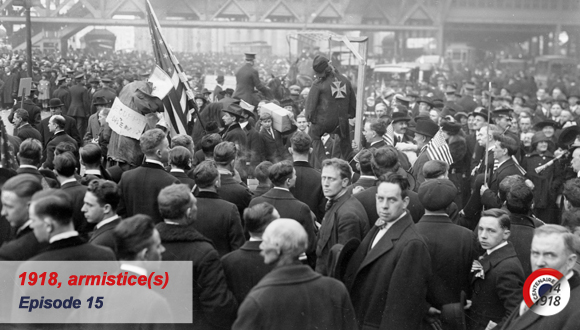Photograph taken in New York, USA with legend Peace Hurrah 11/11/18. This photograph stands in stark contrast to the scenes of jubilation, streets with flags streaming, and joyful crowds usually shown. While the American flag is visible, the most striking thing is the stem, in the centre of photography, from which hangs a dark effigy bearing the cross of the Teutonic knights still used by the German army during the First World War. © Washington, Library of Congress
 This cartoon by William Allen Rogers was published on 7 November 1918, in the New York Herald. The cartoonist added Foch’s name to his pocket so that Americans could recognise him. Four stars can be seen on his sleeve, as opposed to the seven worn by the Marshal. Foch dominates the caricaturally-rendered German officer, wearing a pointed helmet, and dirty uniform with holes. The latter reads with astonishment, using his pair of glasses, the terms dreamed up for the armistice. Above him, the eagle materialising Germany with the inscription “Hun Land” (the Land of the Huns, an insulting term equating them with Barbarians). © Washington, Library of Congress.
This cartoon by William Allen Rogers was published on 7 November 1918, in the New York Herald. The cartoonist added Foch’s name to his pocket so that Americans could recognise him. Four stars can be seen on his sleeve, as opposed to the seven worn by the Marshal. Foch dominates the caricaturally-rendered German officer, wearing a pointed helmet, and dirty uniform with holes. The latter reads with astonishment, using his pair of glasses, the terms dreamed up for the armistice. Above him, the eagle materialising Germany with the inscription “Hun Land” (the Land of the Huns, an insulting term equating them with Barbarians). © Washington, Library of Congress.
Lieutenant Colonel George S. Patton (1885-1945) in front of a Renault FT tank in 1918, in Bourg. Initially, he was part of General Pershing’s general staff. Together, they bow before Napoleon’s tomb at Les Invalides. He would later successfully secure an appointment to direct the creation of the Tank Corps. On Armistice Day, he celebrated his 33rd birthday © Signal Corps Photograph Collection
Announcement of the armistice abroad
Fake news
American newspapers announced the armistice on 7 November 1918, while German plenipotantiaries were still on their way and no official announcement had been made. From that date, New Yorkers celebrated, with music roaring and confetti showering down, the end of the war on the City streets. At 1 p.m., all trading was even stopped on Wall Street.
Bliss and bulwarking
Amongst the associate powers (the USA) and the Allies, but also in neutral countries, the announcement of the armistice, on 11 November, during speeches, like that of President Wilson at the White House, in the newspapers, at the sound of the bells, etc., generally stirred joy and above all relief. Elsewhere as in Paris, men and women left their shops, offices or factories, ultimately congregating on the streets of big cities. Very quickly, posters ask people to plaster their windows with the flag of their country and that of the Allies.
At 11 a.m., 11 November, 11th month of the year
11 a.m., at Paris time, the eleventh day of the eleventh month is the designated date as Armistice and Victory Day for the Allies. However, the following year, the day also became the day of veterans during which those who died in the war were honoured.
Poppy Day
For the British, 11 November is not a public holiday, two minutes of silence are observed at 11 a.m., on the street, shops, transport, etc. Then the second Sunday of November is celebrated as Remembrance Sunday. 11 November bears the name Veterans Day, Remembrance Day (in the USA) or Poppy Day. The poppy, was already associated with memory and eternal rest in Greco-Roman Antiquity. The countries of the Commonwealth associated it with the memory of those who died in war. On Memorial Day, paper poppies were thus sold to benefit the soldiers. The French equivalent is the cornflower.



Ajouter un commentaire